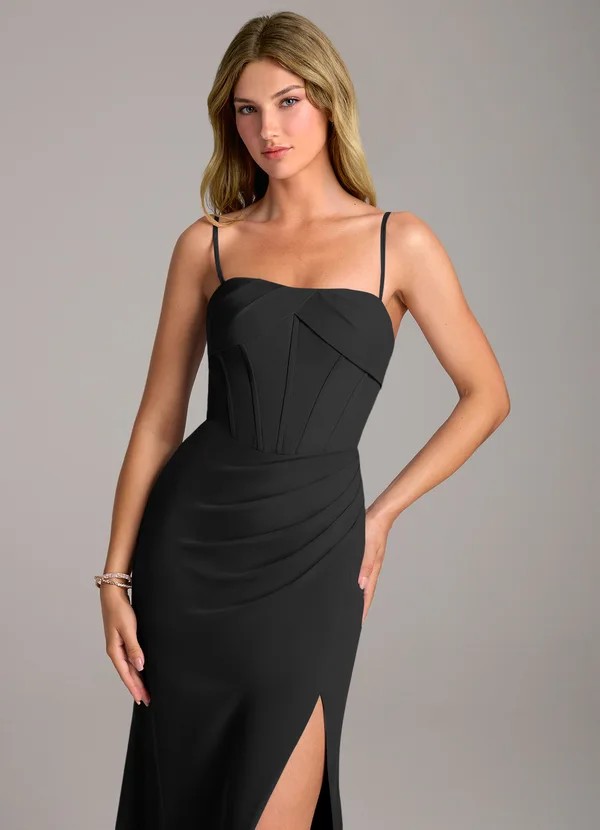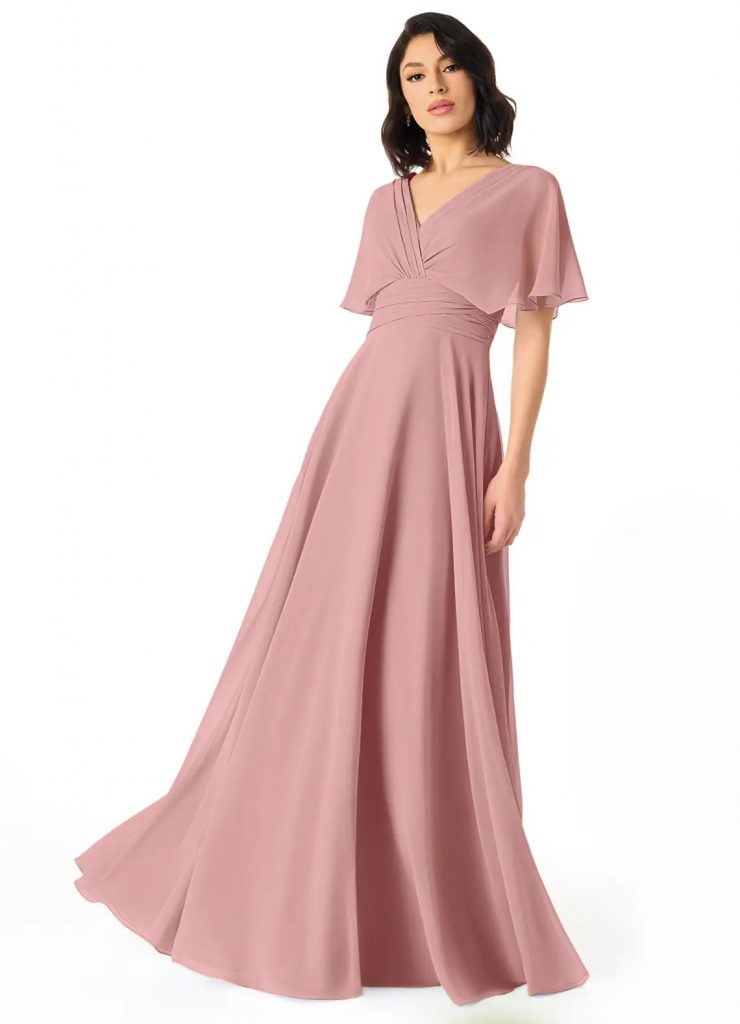How Do I Handle Different Bridesmaid Body Types for a Cohesive Look?
No two bridesmaids have the same body shape — and that’s a beautiful thing.
From curvy to petite, tall to athletic, your bridal party is a mix of personalities and silhouettes.
The challenge is finding dresses that make everyone feel comfortable and confident while still looking coordinated in photos.
To handle different bridesmaid body types while keeping a cohesive look, choose a common color, fabric, or theme and allow flexibility in silhouettes and necklines.Styles like A-line, wrap, and empire waist flatter most figures.
Use mix-and-match designs that share one unifying detail, such as color tone or fabric finish. Include every bridesmaid in the fitting process to ensure comfort and confidence. The goal is harmony — not identicality — for a naturally elegant group appearance.
Core Co-ordination Table
| Element | Keep Consistent | Allow Variation | Why It Works |
| Color | One shade or tonal range | Slight hue variation | Creates harmony in photos |
| Fabric | Same texture or finish | Different silhouettes | Keeps dresses cohesive |
| Length | Same hemline | Personal neckline choice | Uniform yet comfortable |
| Accessories | Matching tone family | Individual jewelry | Maintains theme balance |
| Bouquets | Unified floral palette | Slight style variety | Connects visuals naturally |
Understanding Body Diversity in Your Bridal Party

Every bridesmaid brings her unique shape, style preference, and comfort level. Recognizing these differences early helps you plan inclusively.
Here are the most common body shapes to consider:
- Hourglass: Balanced shoulders and hips with a defined waist.
- Pear: Smaller upper body with fuller hips and thighs.
- Apple: Fuller midsection, slim legs, less defined waist.
- Rectangle: Balanced proportions with minimal curves.
- Inverted Triangle: Broad shoulders, narrower hips.
- Petite: Shorter frame, smaller proportions.
- Tall: Long limbs, elongated torso.
Start With a Unifying Vision
Before diving into dress styles, define your visual theme.
Ask yourself:
- Do you want a romantic, boho, classic, or modern look?
- What color palette matches your wedding design?
- Will your photos be indoors, outdoors, or both?
Once you have your vision, select one cohesive anchor element that ties the looks together:
- Color Family: All sage, mauve, or champagne tones.
- Fabric Type: All chiffon or satin.
- Length Rule: All full-length or midi.
Keeping one of these constant allows you to embrace diversity in silhouette without losing balance.
Choose Universally Flattering Silhouettes
Some cuts and shapes complement nearly all figures. These can form your base “menu” of approved styles for your bridesmaids to choose from.
Top universally flattering styles:
- A-line: Fitted bodice with a gentle flare from waist down.
- Wrap Dress: Adjustable waist tie; ideal for comfort and curves.
- Empire Waist: Emphasizes bust while skimming midsection.
- V-neck: Elongates neckline and balances shoulders.
- One-shoulder or Off-shoulder: Adds elegance while offering support.
Why it works:
Each bridesmaid can express her personality while staying within your cohesive visual framework.
Use a Mix-and-Match Approach

The “mix-and-match” trend is the perfect solution for bridal parties with diverse body types.
It combines unity and individuality seamlessly.
How to Mix and Match Successfully
- Same Color, Different Style: Keeps the palette unified while allowing freedom in silhouette.
- Same Fabric, Coordinated Colors: Works well for ombré or gradient looks.
- Same Designer Collection: Ensures consistent material and quality.
- Similar Neckline Family: For example, all soft V-necks or strap options in the same hue.
Tip: Limit variation to 2–3 main dress styles. Too many differences can break visual balance.
Let Color Bring Everything Together
Color is your strongest tool for cohesion.
- Single Shade Approach: One dominant color across all dresses (e.g., dusty blue).
- Tonal Harmony: Mix tones within the same color family (e.g., blush, rose, mauve).
- Gradient Effect: Light to dark transitions in group photos.
- Contrast Harmony: Mix complementary shades like champagne and taupe for depth.
Pro Tip: Test the color palette in different lighting (daylight vs. evening) to ensure consistency across fabrics and skin tones.
Match Fabric, Not Necessarily Form
Even with different cuts, using the same fabric type instantly unifies the look.
- Chiffon: Flowy, light, ideal for outdoor or summer weddings.
- Satin or Charmeuse: Sleek, reflective, perfect for formal indoor settings.
- Velvet: Rich and elegant for autumn or winter weddings.
- Crepe: Smooth, modern texture with easy drape.
Tip: Avoid mixing matte and shiny fabrics — it can create unbalanced light reflection in photos.
Keep Length Consistent
Different necklines and silhouettes can coexist beautifully as long as the hemlines align.
Options:
- Full-Length: Timeless and flattering across heights.
- Midi-Length: Great for outdoor or garden weddings.
- High-Low: Adds modern flair while showing shoes evenly.
Matching lengths maintain rhythm in photos and prevent awkward height contrasts.
Account for Height Differences
Balancing proportions for tall and petite bridesmaids ensures everyone appears even in group shots.
For Petite Bridesmaids:
- Empire waist elongates legs.
- Lighter fabrics like chiffon prevent overwhelming the frame.
- Avoid heavy embellishment or full skirts.
For Tall Bridesmaids:
- Column or A-line shapes show height gracefully.
- Structured fabrics like crepe provide polish.
- Ensure hemline properly covers heels to avoid ankle exposure.
Tip: Use consistent heel heights if the group photo setup emphasizes symmetry.
Include All Sizes With Custom Fit Options
Every bridesmaid deserves to feel amazing, regardless of size. Opt for retailers offering custom sizing to eliminate alteration stress. Made-to-measure dresses ensure the same style fits comfortably across all body types.
Custom Size Advantages:
- Accurate fit for bust, waist, and hip proportions.
- Prevents issues like gaping necklines or tight waists.
- Minimizes post-order tailoring.
Encourage all bridesmaids to provide measurements early (bust, waist, hips, and height). Provide measurement guides or schedule a group measurement session for consistency.
Coordinate Accessories Thoughtfully
Accessories unify diverse silhouettes without forcing identical dresses.
Ideas for Balance:
- Same earrings or bracelet design.
- Matching hair accessories (clips, ribbons, or floral crowns).
- Consistent shoe color or tone.
- Coordinated bouquets for symmetry.
Tip: Choose understated, cohesive accessories so the dresses remain the focal point.
Plan Group Fittings and Try-Ons

Organize a try-on day or shared video call for remote bridesmaids.
This helps you visualize:
- How colors and fabrics look together.
- Which silhouettes photograph best.
- If anyone needs adjustments or comfort changes.
Benefits:
- Avoids last-minute surprises.
- Encourages bridesmaids to give feedback.
- Builds excitement and unity among the group.
Embrace Inclusivity and Comfort
The best bridal parties radiate confidence — and confidence starts with comfort.
- Ask for input early: listen to each bridesmaid’s comfort zone (necklines, coverage, sleeves).
- Offer sleeve or strap variations for those who prefer coverage.
- Select breathable fabrics for warm weather events.
- Ensure enough time for alterations so no one feels rushed.
Remember: When everyone feels beautiful, the entire wedding party looks harmonious.
Visual Guide: Flattering Silhouettes by Body Type
| Body Type | Best Silhouettes | Neckline Tips | Why It Works |
| Hourglass | A-line, wrap, fit-and-flare | V-neck, off-shoulder | Defines waist and balances curves |
| Pear Shape | Empire waist, A-line | Sweetheart, halter | Highlights shoulders, minimizes hips |
| Apple Shape | Empire, flowy A-line | Scoop, deep V-neck | Lengthens torso, skims midsection |
| Rectangle | Wrap, belted sheath | Square, one-shoulder | Adds waist definition and curves |
| Inverted Triangle | Ballgown, A-line | Scoop, sweetheart | Balances upper body width |
| Petite | Sheath, empire | Spaghetti strap, V-neck | Elongates silhouette |
| Tall | Mermaid, column | High neck, bateau | Accentuates height elegantly |
Consider Wedding Setting and Season
Different venues and climates can influence what looks cohesive:
- Outdoor Spring Wedding: Pastels, chiffon, midi-length flowy designs.
- Summer Beach Wedding: Light tones, breathable fabrics, and relaxed fits.
- Fall Indoor Celebration: Deep hues, velvet or crepe, and structured cuts.
- Winter Formal Event: Jewel tones, long sleeves, and elegant satin.
Tip: Let season guide your palette while keeping comfort top of mind.
Keep the Bride’s Dress as the Anchor
Your bridal gown naturally sets the tone for the party.
If your dress is minimalist, bridesmaids can feature more texture or variety. If your gown is elaborate, simpler bridesmaid silhouettes maintain focus on you.
Coordinating Strategy
- Match the level of formality.
- Choose complementary necklines.
- Maintain balance — the bride should always stand out naturally.
Group Photo Styling Tips
Cohesion isn’t just about dresses — it’s about how everything comes together in photos.
Photography Tips
- Alternate silhouettes for visual rhythm.
- Line bridesmaids by color tone for gradient effects.
- Ensure similar posture and bouquet positions.
- Avoid strong lighting contrasts that exaggerate fabric differences.
Tip: Do a quick “photo test” during your fitting day — it’s the best way to confirm harmony on camera.
Celebrate Confidence Over Uniformity

At the heart of all these choices is one goal:
Every bridesmaid feels beautiful and appreciated.
A cohesive bridal party doesn’t mean identical outfits. It means a unified mood — the kind that radiates joy, comfort, and self-assurance.
Checklist for a Cohesive Yet Inclusive Bridal Party
- Decide on one cohesive element (color, fabric, or length).
- Choose 2–4 flattering silhouettes for variety.
- Offer custom sizing for all body types.
- Maintain a consistent hemline or fabric finish.
- Unify accessories and bouquets.
- Plan group fittings and feedback sessions.
- Prioritize comfort and confidence above all.
Frequently Asked Questions
Should all bridesmaids wear the same dress style?
Not necessarily. Modern weddings embrace mix-and-match designs, allowing bridesmaids to pick silhouettes that flatter them while staying within your color or fabric theme.
How do I make sure all dresses look cohesive in photos?
Keep one main design element consistent — color, fabric, or length. Avoid mixing shiny and matte materials or drastically different shades.
What if one bridesmaid wants sleeves and others don’t?
Offer sleeve options in the same fabric. As long as the color and length match, the group will still appear unified.
How far in advance should I plan fittings for different body types?
Order dresses at least 6 months before the wedding. This allows time for alterations and any size adjustments.
How do I handle sensitive body image concerns?
Encourage open communication. Let bridesmaids privately share preferences on coverage and fit. A little empathy goes a long way toward creating a confident, cohesive group.
What if my bridesmaids have very different heights?
Choose the same hemline but adjust heel height or hem length slightly for balance. This keeps everyone visually aligned in photos.
